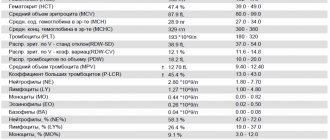Blood clotting can indicate a person's health status.
With normal coagulation, blood will circulate freely through the veins and arteries, thereby supplying the organs with useful substances. Even if a person damages the skin down to small arteries, with normal blood clotting, the wound will quickly heal.
But if the plasma is too thick or thin, health problems begin, which sometimes pose a threat to life.
An analysis to detect plasma coagulability is called a coagulogram or hemostasiogram.
What is this and what does it affect?
It is very important to know how thin or thick a person’s blood is.
Attention! Clotting is an important indicator of health. This is primarily a protective function of the body. This way there is no blood loss and its volume is maintained.
The mechanism of coagulation depends on the physicochemical actions in the molecular system of the plasma:
- The main place in this is occupied by a protein called fibrinogen.
- During the reactions that take place, it is converted into fibrin (which is not able to dissolve), which falls out in the form of the thinnest threads.
- These threads can form into a dense network with small cells that trap the formed elements.
- These changes lead to the formation of a blood clot. As it exists, its base becomes compacted, the edges of the wound are tightened and healing occurs.
- As the clot tightens, it forms a yellowish liquid called serum.
Platelets, which are part of the plasma, influence the compaction of the blood clot.
To use a primitive comparison, the process of blood clotting is reminiscent of the process of turning milk into cottage cheese, when casein (milk protein) coagulates and whey is released. Over time, the wound resolves and the fibrin clot dissolves.
The plasma coagulation test is used when the presence of the following diseases is suspected:
- pathology of the liver organ,
- disorders of the immune system,
- varicose veins.
Specialists also send patients for hemostasis testing before surgery, during pregnancy, and in case of possible large blood losses.
The video explains how the blood clotting system works:
Basics of Keeping Blood Fluid
Blood maintains the constancy of its structure. This means that, on the one hand, it must be thick enough so as not to sweat through the vascular wall under the influence of pressure in the vessels, which is pumped up by the heart. On the other hand, blood that is too thick will not be able to circulate through the capillary networks and other vascular structures of the microvasculature. Therefore, it must have a balance that is controlled by the system of coagulation (coagulation) and anticoagulation (anticoagulation). Collectively this is called coagulation homeostasis. As long as both systems are in harmonious interaction, the body functions normally.
Important to remember! Impaired blood clotting can cause many diseases, primarily those associated with blood vessels and the heart. But this is not its only meaning. It almost always changes its coagulation properties against the background of severe pathology!
Blood coagulation and the ability to form a clot are affected by:
- Condition of the vascular walls. Violation of the structure of the inner layer of arteries triggers processes of increased coagulation;
- The number and functional usefulness of platelets. They are the main overseers of the integrity of the vascular bed and are the first to initiate the process of accelerated coagulation;
- Concentration and state of plasma coagulation factors. Most of them are synthesized by the liver with the participation of vitamin K and the vascular endothelium. An increase or decrease in their number leads to an increase or decrease in blood clotting;
- Concentrations of plasma factors of the anticoagulation system (antithrombin, heparin, antiplasmin and others). The more there are, the thinner the blood.
Norm by age (table)
On average, there are up to 30 types of blood clotting tests. Most often these are laboratory tests. Blood is taken either from a finger or from a vein.
For various types of analysis, capillary or venous blood will be needed, which makes it possible to identify hemostasis (clotting) in individual parts of the plasma.
In adult men and women, children, normal indicators will differ, and each individual analysis will reveal its own calculations.
Attention! Platelets play an important role in the blood composition; their increase or decrease affects hemostasis. Normally, in adults, the amount of these elements is 150-400 g/l; in children, this figure is slightly lower, from 150 to 350 g/l.
All norm results are shown in more detail in the tables below.
| Type of test | Norm | Type of plasma |
| Platelet determination | Adults 150-400 g/l | Capillary (from a finger) |
| In childhood 150-350 g/l | ||
| By clotting time | According to Sukharev: start – 30-120 seconds; completion – between 3 and 5 minutes. | Capillary |
| Lee-White indicator 5-10 minutes | Deoxygenated blood | |
| Detection of bleeding duration according to Duke | No more than 4 minutes | Capillary blood taken from a finger |
| Prothrombin index (PTI) | Capillary blood 93-107% | Fingertip |
| 90-105% of blood from a vein | Taken from a vein | |
| Activated partial thromboplastin time (aPTT) | The indicator is not determined by age and gender, the result is the same for everyone: 35-50 seconds | Venous |
| Fibrinogen | Adult patients 2-4 g/l; in infants in the first days of life 1.25-3.0 g/l | From Vienna |
Above is an incomplete table of all analyses. Some of them will be presented below.
The essence of the main analyzes
The norm of any analysis is an average indicator that needs to be able to be correctly compared with the results of the blood being tested. In this case, all those natural factors that can naturally influence the result of the coagulation study must be taken into account. These include:
You can also read: Decrease in platelets in the blood
- Women, especially during menstruation. All their indicators may be reduced. During pregnancy there is a tendency to increased coagulability;
- Taking oral hormonal contraceptives helps increase blood clotting;
- Taking anticoagulants and other blood thinners;
- Dehydration of the body and exposure to high temperatures causes conditions in which the norm of coagulation indicators may be exceeded;
- Major injuries, surgeries, transfusions of blood and its components.
The essence and diagnostic capabilities of the main indicators of blood coagulation are given in the table.
| Coagulability index | What does it mean |
| Platelet level | Reflects the number of cells that are responsible for starting blood clotting when the integrity of the vascular wall is violated. |
| Coagulation time according to Sukharev | Reflects the ability of capillary blood to form a clot when it is placed in a thin glass capillary with its smooth alternating inclination in opposite directions. The time when the movement of blood becomes difficult and the time when a persistent clot forms is noted. |
| Lee-White clotting time | The analysis is carried out by analogy with Sukharev’s technique. The only difference is that this analysis requires venous blood. |
| Thrombin time | Shows the state of the last phase of blood coagulation. Indirectly indicates the concentration of administered drugs and natural factors of the coagulation and anticoagulation systems. |
| Duration of bleeding according to Duke | Indicates the body's ability to stop blood loss. The method is the simplest of all known. It is tested by recording the time it takes for blood to stop flowing from a small wound after the skin of a finger is punctured. |
| Prothrombin index | Reflects the ability of plasma coagulation factors in the blood being tested to form a clot when tissue coagulation factors produced by platelets are added to them. It is measured as a percentage of the prothrombin time (in seconds) of the test subject to the normal prothrombin time. |
| APTT | It differs from the prothrombin index in that it shows only the activity of plasma coagulation factors without the participation of platelets. |
| Fibrinogen | Determination of the concentration of a specific blood protein that is responsible for strengthening the blood clot. |
The main indicators of blood clotting are associated with the activity of plasma factors of the coagulation and anticoagulation systems
Time tests
Clotting time is included in the parameters of hemostasis. There are circumstances when it is necessary to know about this indicator, for example, during a certain period of life or during a person’s illness. Most often, studies are carried out by taking part of the blood.
The clotting period is divided into two stages:
- Primary hemostasis . At this time, to stop blood loss, vasoconstriction occurs and a blood clot is mechanically formed to prevent bleeding from the site of platelet damage.
- Secondary hemostasis is coagulation.
General recommendations for all analyzes include:
- Almost all tests are taken in the first half of the day, since over the next hours the indicators may change depending on nutrition, physical activity, etc.
- During the day before the test, food should be light, and 12 hours before going to the laboratory, eating is completely prohibited.
- You should not drink sugary drinks at this time. It is better to drink regular boiled water.
- You should definitely notify your doctor about taking medications.
It is very important to know over what period these two stages should normally occur. For this purpose, special analyzes are carried out.
The video explains how to determine blood clotting using a general analysis and at home:
According to Sukharev
For this test you do not need to donate blood from a vein. The sample is taken from a finger, since capillary biological fluid is sufficient. This test examines the amount of enzymes.
Attention! Thanks to blood testing according to Sukharev, doctors can learn about the body’s ability to withstand severe blood loss or other hemostasis disorders.
At the same time, the analysis gives a general picture of the state of the nervous and endocrine systems.
How the analysis is carried out:
- In the morning before the test, you cannot eat anything; the test itself involves taking blood in the morning.
- It is acceptable to drink ordinary water, but without gas.
- First, a puncture is made in the finger using a scarifier needle, and the required amount of plasma is squeezed out of it.
- To check the thickness of the blood, the laboratory technician begins to rock the test tube so that the liquid flows down the walls; depending on the time of flow, the result is recorded. That is, the time is recorded from the beginning of blood flow to the formation of a clot.
What results does Sukharev’s method give:
- If the clotting time is normal, then this indicates the absence of diseases associated with hemostasis.
- If clotting occurs in a short period of time, there is a risk of blood clots. An exception may be pregnancy, when rapid blood clotting is due to the protective functions of the body. A similar phenomenon can occur after taking contraceptive medications. This is also observed after childbirth, operations, heavy blood loss, extensive burns, and certain illnesses.
- If clotting does not occur for a long time, then the person loses a lot of blood, which affects his well-being and can be life-threatening. This happens due to various pathologies or while taking certain medications.
A normal analysis indicator is considered to be a clotting time in a healthy person of 3 to 5 minutes.
In childhood, this figure is slightly reduced and is 2-5 minutes.
In older people, for health reasons and some physiological changes in the body, the clotting time is reduced to 1.5-2 minutes , as the liquid becomes thicker.
The same indicators during pregnancy ( 1.5-2 minutes ). This is due to the fact that the body develops protective mechanisms to protect the growing fetus.
General rules for conducting analyzes
Regardless of what coagulogram indicator will be examined and what kind of blood is needed for it, the subject must adhere to certain rules:
- Blood sampling is carried out in the morning;
- Avoid eating 8-10 hours before the test and drinking alcohol the day before;
- Avoid smoking 3-4 hours before the test;
- Immediately before taking the test, it is advisable for the body to remain at rest for several minutes.
Blood collection and analysis depends on its type. Those methods that require capillary blood are carried out immediately after puncturing the skin of one of the fingers with a scarifier or a special needle. If venous blood is needed for research, about 20 ml of it is taken according to the general rules in one of the peripheral veins. After collection, it must be delivered to the laboratory within 2 hours and centrifuged to obtain plasma. It is this part of the blood that is examined during the determination of coagulogram parameters.
Reasons for deviation from the norm
If clotting time indicators do not indicate normality, then we can talk about the presence of various diseases. A deviation is considered to be both a slow coagulation process and accelerated rates.
Increased speed
With an increased hemostatic system, the reasons are as follows:
- Diseases associated with the liver organ. For example, this is the decompensated stage of cirrhosis, hepatitis, and cancer. In this case, the liver parenchyma is assessed as incompetent.
- Lack of coagulation factors, or their inferiority. More often, this process is affected by a lack of necessary proteins in the blood. Therefore, normal coagulation does not occur.
- Terminal stages of disseminated intravascular coagulation syndrome (DIC syndrome).
- The period when the body suffers from intoxication.
- Atherosclerosis.
- Presence of infections.
- Congenital genetic abnormalities.
Reference! Sometimes external factors influence clotting. For example, taking certain medications - anticoagulants and antiplatelet agents, as well as heparin therapy. Such patients should undergo blood clotting tests more often than others.
So, when taking wafarin, you will need monthly INR monitoring.
What increased blood clotting can lead to is explained in the video:
Reduced speed
If hemostasis indicators are reduced, this may indicate the following factors:
- Hypercoagulation. It is characterized by the initial stage of disseminated intravascular coagulation syndrome.
- Diseases with an increased risk of thrombosis. These are arterial hypertension, atherosclerosis, dyslipidemia, in which there is a high level of cholesterol in the blood. The same group can include thrombosis, thrombophlebitis and varicose veins.
- If a woman takes oral hormonal contraceptives for a long time.
- The clotting rate is affected, especially over a long period, by drinking alcoholic beverages and smoking.
- If dehydration occurs.
- Taking corticosteroids for a long time. It is worth noting that taking these drugs affects the functioning of the entire body.
Why is coagulation disrupted and what are its consequences?
The norm of indicators of the hemostasis system can be exceeded for the following pathological reasons:
- An increase in the level of platelets due to their excessive production by the bone marrow;
- Infectious-toxic and septic diseases;
- Any intoxication that occurs against the background of severe pathology of internal organs;
- Widespread atherosclerotic vascular lesions;
- Congenital and genetic abnormalities of anticoagulant system factors;
- Artificial heart valves and vascular prostheses;
- Autoimmune diseases;
- Endocrine pathology with metabolic disorders in the body;
- Blood stagnation due to heart failure and physical inactivity;
- The first phase of DIC syndrome.
Indicators of clotting tests may be lower than the generally accepted norm. The following reasons will lead to this:
- Thrombocytopenia;
- Hemophilia and other hereditary defects of clotting factors;
- Hemolytic anemia;
- Leukemia;
- Decompensated liver failure with cirrhosis;
- Insufficient amount of calcium and vitamin K in the body;
- Overdose and treatment with anticoagulants (heparin, warfarin, acetylsalicylic acid preparations);
- The last phase of DIC syndrome.
Important to remember! Increased blood clotting is dangerous due to the accelerated formation of blood clots in the vessels, which can cause thrombosis of the arteries and veins of internal organs, limbs and brain. Decreased coagulability is fraught with an increased risk of massive and profuse bleeding!
The study and correct interpretation of blood clotting test data allows you to determine all the risks regarding the potential for vascular diseases, as well as monitor the effectiveness of the blood thinners used and their dosage.
When does it become necessary to get tested?
In some situations, your doctor may strongly recommend a blood clotting test.
These may be the following reasons:
- If a young couple plans to get married and subsequently conceive a child. In this case, it is especially important to test for hemosyndrome or MCV.
- When the patient has autoimmune systemic diseases.
- In case of liver failure.
- Diseases of the heart and blood vessels.
- Before surgery, during a routine examination, a plasma coagulation test is taken. The analysis will also be needed after the operation.
- If a diagnosis of thrombophilia is made. This is a tendency to quickly form blood clots.
- Varicose veins.
- If a person often finds bruises on his body.
- If a person experiences prolonged bleeding after tooth extraction, surgery, or other injuries.
- For prolonged nasal, uterine or hemorrhoidal bleeding.
- If the causes of decreased immunity in a person have not been determined.
- If there is acute inflammation in the body.
Attention! Also, a coagulogram is indicated for newborn babies (to exclude congenital pathologies of hemostasis), women entering menopause, pregnant women, and all people over 40 years of age.
Blood clotting
Blood clotting is the ability to form blood clots (thrombi) when tissue is damaged.
We recommend reading the article about the autoimmune bleeding disorder - antiphospholipid syndrome. From it you will learn about the causes and symptoms of antiphospholipid syndrome, types of pathology, diagnostics, treatment methods and prognosis for patients. And here is more about anticoagulants and bleeding.
What is the blood coagulation system
The blood coagulation system is responsible for stopping bleeding. Factors involved in the process of thrombus formation:
- plasma (contained in the liquid part of the blood), there are 12 of them and they are designated by Roman numerals, the main ones: I (fibrinogen), II (prothrombin), fibrinogen is formed from fibrin filaments (the “mesh” of the blood clot);
- tissue - they are produced by the inner lining of blood vessels, stimulate the connection of platelets (cells involved in the construction of a clot);
- cellular - secreted onto the surface of platelet membranes, indicated by Arabic numerals.
If there is no damage to the vessel, then the factors are in an inactive state. After an injury, a cascade reaction occurs - the activation of one enzyme triggers a chain of successive transformations.
What does it depend on
The process of blood clotting (hemocoagulation) depends on the following conditions:
- the condition of blood vessels - with spasm and damage, inflammation accelerates;
- concentration and activity of platelets - their lack or inferiority causes increased bleeding;
- formation of plasma factors in the liver - liver failure is accompanied by a tendency to bleeding;
- the presence of vitamins, especially K, as it is needed for the synthesis of coagulation factors;
- the level of natural anticoagulants (dissolve already formed fibrin threads or inhibit the activation of factors) - heparin, antithrombin and others;
- pain and stress with the release of adrenaline - in their presence, blood clots form faster;
- calcium, blood thickness - enhance coagulation;
- temperature of the body and the external environment - heat accelerates, and cold slows down the formation of a blood clot;
- taking medications - for example, Heparin, Warfarin, Aspirin causes bleeding, and is stopped by Vikasol (an analogue of vitamin K), aminocaproic acid, Dicynon.
How it happens
Blood clotting begins after a reflex spasm of the vessel in response to damage and occurs in the form of reactions:
- platelet adhesion (adhesion) – causes von Willebrand factor released during injury to the vessel lining;
- formation of platelet plugs (aggregation) - activated platelets adhere to each other;
- contraction and compaction of the thrombus - released platelet factors make aggregation irreversible, thrombin is formed, causing the conversion of fibrinogen into fibrin threads.
In a simplified form, fibrin threads are a kind of mesh in which platelets are located, and red blood cells and leukocytes are also captured from the blood. All cells, thanks to special tightening proteins, are tightly connected to each other into a blood clot.
Stages and conditions
Blood clotting is a multifactorial process. Some reactions occur sequentially, but the main ones occur simultaneously, so their division into stages is arbitrary. There are 3 main stages:
- activation - prothrombin turns into thrombin;
- coagulation - thrombin “cuts off” parts of fibrinogen and fibrin threads appear;
- retraction – compression and compaction of fibrin clots.
The first phase can be started in two ways:
- external - tissue factors that are released from a destroyed vessel or connective tissue;
- internal - due to factors that are on the membrane of activated platelets (intravascular pathway).
What causes violations
Increased coagulability occurs in the following diseases:
- atherosclerosis;
- hypertonic disease;
- vascular complications of diabetes mellitus (angiopathy);
- increased destruction of red blood cells (hemolytic anemia);
- autoimmune diseases (antibodies are formed to one’s own tissues) – rheumatoid arthritis, periarteritis nodosa;
- severe injuries, burns, shock (first stage);
- blood poisoning (sepsis);
- increased production of stress hormones by the adrenal glands (pheochromocytoma, Itsenko-Cushing syndrome);
- dysfunction of the kidneys and pancreas.
With all these conditions, the risk of blockage of blood vessels with blood clots and complications in the form of organ infarctions and stroke increases.
Low blood clotting leads to bleeding. It can be a consequence of congenital diseases (hemophilia, von Willebrand, Randu-Osler, deficiency of coagulation factors), and it is also provoked by:
- infections – viral and microbial;
- medications - anticoagulants, antiplatelet agents, some antitumor drugs;
- neoplasms, including blood (leukemia), bone marrow;
- cirrhosis of the liver;
- lack of vitamin K;
- intravascular coagulation in severe shock and septic conditions (the second phase of DIC syndrome, that is, widespread intravascular coagulation);
- irradiation;
- frequent blood transfusions;
- chronic alcoholism;
- hemorrhagic vasculitis.










